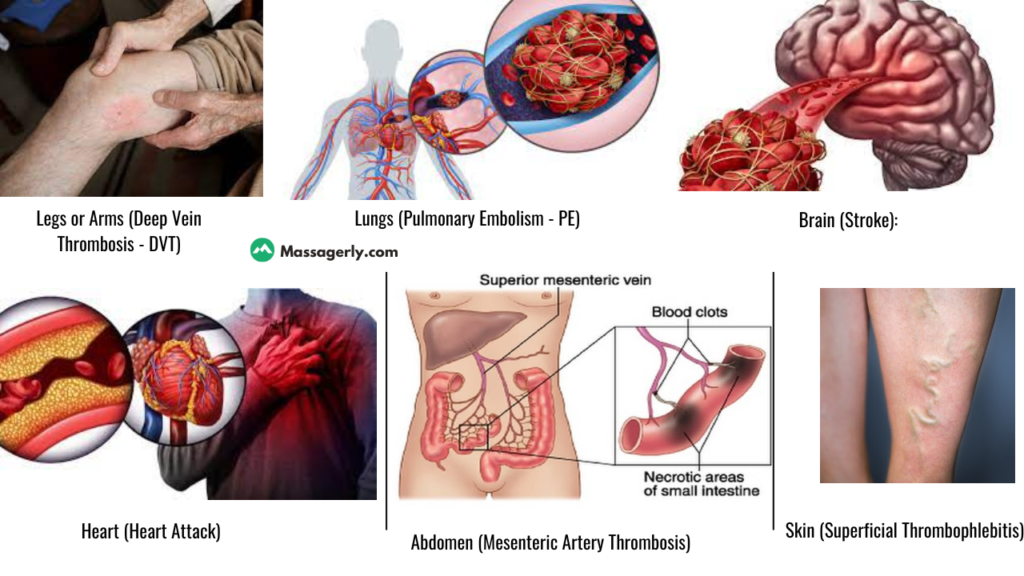Can Massage Dislodge a Blood Clot? Imagine a world where the power of touch could potentially alleviate one of the most critical health concerns today. In a landscape where blood clots affect a staggering percentage of individuals, exploring the role of massage in dislodging these life-disrupting obstacles becomes an intriguing pursuit. According to recent medical reports, blood clots impact millions worldwide, with their prevalence only growing. As you embark on this journey to uncover the truth, prepare to be amazed by the potential benefits that massage therapy might offer in the realm of blood clot dislodgement. From separating myths from realities to delving into the scientific intricacies, this exploration promises to keep you captivated.
So, fasten your seatbelt, as we navigate through the realms of wellness and wonder, all centered around the question: Can massage truly make a difference in the battle against blood clots? Get ready to discover a whole new dimension of relief at your fingertips.
Can Massage Really Dislodge a Blood Clot?
Short Answer: No, Massage Can’t Dislodge Blood Clots
What’s a Blood Clot?
- A blood clot is like a sticky clump that forms when blood thickens and sticks together.
- It’s a natural response to stop bleeding when we get hurt.
Why Can’t Massage Help?
- Blood clots can be dangerous if they block important blood vessels.
- Massaging or pressing on a clot can make it break into pieces.
- These pieces can travel in the blood and cause big problems.
What’s the Risk?
- If a clot piece gets stuck in a small blood pipe, it’s like a traffic jam in your bloodstream.
- This can lead to serious issues like heart attacks, strokes, or damage to organs.
What Should You Do?
- If you think you have a blood clot, don’t try to massage it away.
- Tell a doctor about your symptoms: swelling, pain, redness, or warmth in a limb, sudden shortness of breath, chest pain, or confusion.
Remember:
- Blood clots need proper medical care.
- Doctors use medicines (like blood thinners) to help the body handle clots safely.
- Trust medical experts for the right advice about your health.
Stay safe and seek help from doctors if you’re worried about blood clots!
4 Effective Ways: How Can Massage Help a Pinched Nerve ?
Reasons for Blood Clot
- Immobility: Prolonged periods of immobility, such as long flights or bed rest, can lead to sluggish blood flow, increasing the risk of clot formation.
- Surgery: Surgical procedures can cause blood vessels to be damaged, triggering the body’s clotting response as a part of the healing process.
- Injury: Trauma or injury to blood vessels can activate the clotting cascade, leading to the formation of clots.
- Smoking: Smoking damages blood vessel walls and promotes a pro-inflammatory state, increasing the risk of clotting.
- Obesity: Excess body weight can contribute to inflammation and alter blood flow, making clot formation more likely.
- Medical Conditions: Certain medical conditions, such as cancer, autoimmune disorders, and inflammatory conditions, can increase the risk of blood clotting.
- Genetics: Inherited conditions like Factor V Leiden mutation or antithrombin deficiency can make blood more prone to clotting.
- Hormonal Changes: Hormonal fluctuations, particularly in women taking birth control pills or undergoing hormone replacement therapy, can elevate clot risk.
- Pregnancy: Pregnancy increases the risk of clot formation due to hormonal changes, increased pressure on blood vessels, and reduced blood flow in some areas.
- Age: As people age, blood vessels can become less elastic, and blood flow may slow down, both contributing to clot formation.
- Underlying Diseases: Conditions like heart disease and diabetes can damage blood vessels and disrupt normal blood flow, leading to clot formation.
- Dehydration: Insufficient hydration can cause blood to become thicker, making it more prone to clotting.
- Medications: Certain medications, such as hormone therapies, certain cancer treatments, and some antipsychotic drugs, can increase the risk of clot formation.
- Varicose Veins: Damaged or weakened veins, often seen in varicose veins, can slow down blood flow and contribute to clot formation.
- Sedentary Lifestyle: Lack of regular physical activity can impair blood circulation and increase the likelihood of clot formation.
- High Blood Pressure: Elevated blood pressure can damage blood vessel walls, promoting the initiation of clotting.
Symptoms of Blood clots in Different Body Parts

Legs or Arms (Deep Vein Thrombosis – DVT)
- Swelling: Sudden swelling, usually accompanied by pain or tenderness, in the affected leg or arm.
- Pain: Aching or cramping pain, often beginning in the calf and feeling like a sore muscle or charley horse.
- Redness and Warmth: The skin may appear reddish or feel warm to the touch.
- Visible Veins: Sometimes, the affected veins may become more visible or prominent.
Lungs (Pulmonary Embolism – PE):
- Shortness of Breath: Sudden onset of difficulty breathing, especially with activity or at rest.
- Chest Pain: Sharp, stabbing pain in the chest that may worsen with deep breaths or coughing.
- Cough: Dry or with bloody sputum, sometimes accompanied by wheezing.
Brain (Stroke):
- Sudden Weakness or Numbness: Often on one side of the body, including the face, arm, or leg.
- Trouble Speaking: Difficulty forming coherent sentences or slurred speech.
- Vision Changes: Blurred or sudden loss of vision in one or both eyes.
- Severe Headache: Unexplained and sudden onset of severe headache.
Heart (Heart Attack):
- Chest Pain or Discomfort: Pressure, squeezing, fullness, or pain in the center of the chest, which may radiate to the arms, neck, jaw, or back.
- Shortness of Breath: Difficulty breathing, often accompanied by chest discomfort.
- Nausea and Vomiting: Feeling nauseous or vomiting, sometimes accompanied by cold sweats.
Abdomen (Mesenteric Artery Thrombosis):
- Severe Abdominal Pain: Sudden, intense pain in the abdomen that may worsen with movement or eating.
- Nausea and Vomiting: Feeling nauseous or vomiting.
- Diarrhea or Bloody Stools: Sometimes accompanied by rectal bleeding.
Skin (Superficial Thrombophlebitis):
- Redness and Warmth: The affected area may appear reddish and feel warm to the touch.
- Tenderness and Pain: Pain or tenderness along the vein, often worsened by pressure or touch.
- Visible Veins: Prominent or visible veins on the skin’s surface.
Conclusion
No, massage should not be used to attempt to dislodge a blood clot in any area of the body. Massaging a blood clot, regardless of its location, can be dangerous and may lead to the clot breaking apart into smaller pieces. These smaller pieces, known as emboli, can travel through the bloodstream and cause blockages in smaller blood vessels, resulting in serious complications like strokes, heart attacks, or damage to organs.
If you suspect you have a blood clot or have been diagnosed with one, it’s crucial to follow the guidance of medical professionals. Treatment for blood clots typically involves medication, such as anticoagulants (blood thinners), to prevent further clotting and allow the body’s natural processes to safely dissolve the clot over time.
Never attempt to dislodge or manipulate a blood clot through massage or other methods on your own. Seek medical advice and treatment to ensure your safety and well-being.
FAQs
What Happens If You Massage a Blood Clot?
Massaging a blood clot is extremely risky and should be avoided. Applying pressure or massaging a blood clot can cause it to break apart into smaller pieces. These fragments can travel through the bloodstream and get lodged in smaller blood vessels, leading to serious complications such as strokes, heart attacks, or damage to organs. It is essential to seek medical advice and follow proper treatments if you suspect a blood clot.
How Long to Massage a Possible Blood Clot?
Under no circumstances should you attempt to massage a possible blood clot. Massaging a blood clot can lead to dangerous consequences. If you suspect you have a blood clot, seek medical attention immediately rather than attempting self-treatment.
Can You Massage a Blood Clot in the Leg?
No, you should never massage a blood clot in the leg. Massaging a blood clot can cause it to break apart, leading to severe complications. If you suspect a blood clot in your leg, it’s crucial to consult a medical professional for proper diagnosis and treatment.
Can Neck Massage Cause a Blood Clot?
While the direct cause of blood clots from neck massage is rare, any unnecessary or forceful pressure on the neck can potentially increase the risk of blood clot formation. It’s advisable to avoid applying pressure to the neck, especially if you have existing health conditions that may predispose you to blood clot formation.
How to Massage a Blood Clot in the Leg?
It’s important to clarify that you should not attempt to massage a blood clot in the leg. Massaging a blood clot can lead to dangerous complications. If you suspect a blood clot, seek medical attention promptly. Medical professionals will recommend appropriate treatments, such as anticoagulant medications, to ensure the safe resolution of the clot.
Remember, when dealing with potential blood clot issues, always rely on medical experts for guidance and treatment. Never attempt to massage or manipulate a blood clot on your own.

